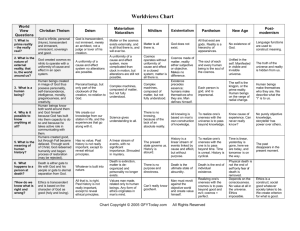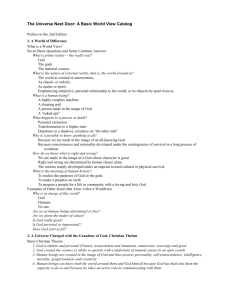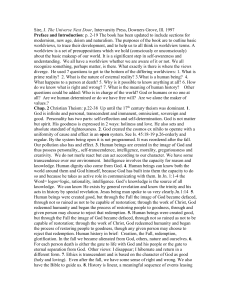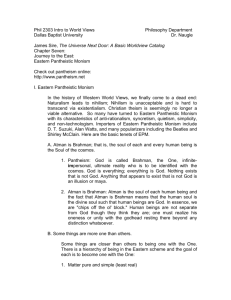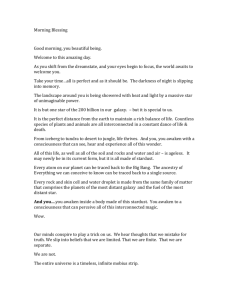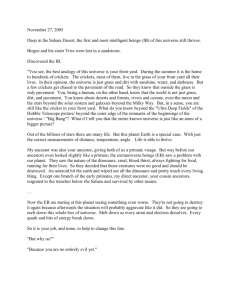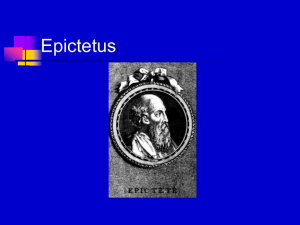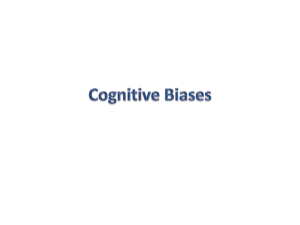worldview - Andrews University
advertisement
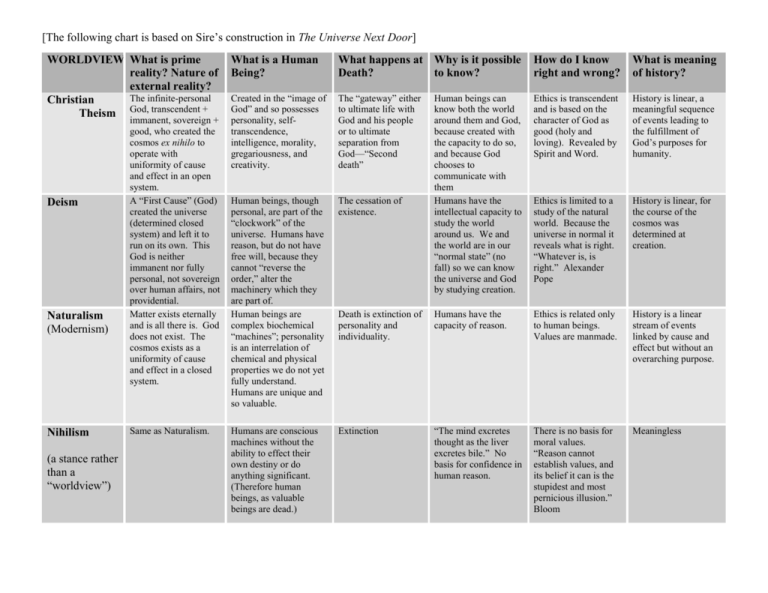
[The following chart is based on Sire’s construction in The Universe Next Door] WORLDVIEW What is prime reality? Nature of external reality? The infinite-personal Christian Theism God, transcendent + What is a Human Being? What happens at Why is it possible Death? to know? How do I know right and wrong? What is meaning of history? Created in the “image of God” and so possesses personality, selftranscendence, intelligence, morality, gregariousness, and creativity. The “gateway” either to ultimate life with God and his people or to ultimate separation from God—“Second death” Ethics is transcendent and is based on the character of God as good (holy and loving). Revealed by Spirit and Word. History is linear, a meaningful sequence of events leading to the fulfillment of God’s purposes for humanity. Deism Human beings, though personal, are part of the “clockwork” of the universe. Humans have reason, but do not have free will, because they cannot “reverse the order,” alter the machinery which they are part of. Human beings are complex biochemical “machines”; personality is an interrelation of chemical and physical properties we do not yet fully understand. Humans are unique and so valuable. The cessation of existence. Human beings can know both the world around them and God, because created with the capacity to do so, and because God chooses to communicate with them Humans have the intellectual capacity to study the world around us. We and the world are in our “normal state” (no fall) so we can know the universe and God by studying creation. Ethics is limited to a study of the natural world. Because the universe in normal it reveals what is right. “Whatever is, is right.” Alexander Pope History is linear, for the course of the cosmos was determined at creation. Death is extinction of personality and individuality. Humans have the capacity of reason. Ethics is related only to human beings. Values are manmade. History is a linear stream of events linked by cause and effect but without an overarching purpose. Humans are conscious machines without the ability to effect their own destiny or do anything significant. (Therefore human beings, as valuable beings are dead.) Extinction “The mind excretes thought as the liver excretes bile.” No basis for confidence in human reason. There is no basis for moral values. “Reason cannot establish values, and its belief it can is the stupidest and most pernicious illusion.” Bloom Meaningless Naturalism (Modernism) Nihilism (a stance rather than a “worldview”) immanent, sovereign + good, who created the cosmos ex nihilo to operate with uniformity of cause and effect in an open system. A “First Cause” (God) created the universe (determined closed system) and left it to run on its own. This God is neither immanent nor fully personal, not sovereign over human affairs, not providential. Matter exists eternally and is all there is. God does not exist. The cosmos exists as a uniformity of cause and effect in a closed system. Same as Naturalism. Thecosmos first question is Existentialism The Postmodernism composed postmodernism solely of matter, addresses but to is human not what is beings there reality or howappears we know in two what forms is there, – subjective but how and language objective. functions to construct meaning itself. In other words, there has been a shift in “first things” from being to knowing to constructing meaning. • God is infinite and Theistic Existentialism personal (triune), transcendent and immanent, omniscient, sovereign and good. God created the cosmos ex nihilo to operate with a uniformity of cause and effect in an open system. Humans are created in the image of God, can know something of God and the cosmos and can act significantly. God can and does communicate with us. We were created good but now are fallen and need to be restored by God through Christ. Death is the gate to life with God and his people or to eternal separation from God. Ethics is base on God’s character. • The For truth human about beings reality alone, itself existence is forever hidden precedes from us.essence; All we can people do is tell make stories themselves (narratives). who they are. • We Each canperson have meaning is totally through freeour regarding stories, their but we nature cannot and have destiny. truth. Nothing we • think The highly we know wrought can be and checked tightlyagainst organized reality objective as such. world stands over Apart against from human our beings linguistic and system appearswe absurd. can know nothing. All language is a human construct. We can’t determine the “truthfulness” of the [But isn’t this just language only Theism? Yes, inthe a “usefulness.” way. The existential version of theism is [So the transition goes much more a special like (1) the set of this: emphases within Christian theism than“premodern” it is a notion a revealed separate of world view. metanarrative Some tendencies place the “modern” it(2) at odds with notion of theism. the traditional autonomy of human with access Itsreason starting point, its to a truthconcern, of main is not correspondence the nature of the (3) theor“postmodern” cosmos God, but notionnature, that weand create human our truth as we construct relation to the cosmos language and God.] that serves our purposes. We Allare narratives free so long mask a asplay we for remain power. Any subjects. one narrative Whenused we as die, a metanarrative each of us is is just an oppressive. object among other objects. To reject oppression is to reject all the stories society tells us. [We can trace the movement like this: (1) a “premodern” acceptance of a metanarrative written by God and revealed in Scripture to (2) a “modern” ofare • metanarrative Human beings universal reason personal beings, who yielding when theytruth comeabout to reality to (3) a full consciousness, “postmodern” find themselves in an reduction of all alien universe; metanarratives to whether God exists power plays. (objectively) is a tough question to be solved, not by reason but by faith. [The human situation is ambivalent, for the evidence for order in the universe is ambivalent. The fact of human love suggests a benevolent deity. The fact of hatred and violence, the fact of an impersonal universe, point in the other direction. Consequently, each person, surrounded by much more darkness than light, must choose. In Human full recognition beings make of and themselves against the who they absurdity are by theoflanguages the objective they construct world,about the authentic themselves. person must revolt and create meaning. [If this sounds like existentialism, it’s because existentialism is a step in the postmodern direction.] Sartre said, “existence precedes essence.” We make ourselves by what we choose to do. The I is an activity. The postmodernist says, “we are only what we The choiceourselves must be to a describe radical act Iofisfaith. be.” The not a When a person substance, not chooses an faith, a whole activity, but apanorama floating opens, anddepending most of theon construct propositions the languageofit uses. traditional theism flood in.] So, again there is a shift from (1) the theistic •“premodern” The personal is the notion that human valuable. beings are dignifield by being created in the [Theistic existentialism image of God also stresses theto (2) the “modern” notion that disjunction between the human beings are the objective and subjective product There of their worlds. areDNA I-It template, which itself relationships and is I-Thou the result of unplanned relationships. I-It evolution based relationships are on chance mutations and important, but I-Thou the survival of relationships arethe what fittest, to (3) the give meaning, especially notion a“postmodern” relationship with the of an insubstantial self Thou of all Thous.] constructed by the language it usesEnglund to [See the Harold describe itself. chart] The Ethics, good like action is the consciously knowledge is chosen a action. linguistic “To construct. choose to be Social this or good thatisis to affirm whatever at the society same time takesthe it to value be. of what we choose, because we [Here canthe never shiftchoose goes evil. from We the (1) always choose “premodern” the good.” theistic Sartre ethics based on the The character good is of whatever a atranscendent person chooses. God The whogood is good is part andof has subjectivity; revealed thatit is not measured goodness by to us, a to (2) standard the “modern” outside ethics the individual based on the human notion of dimension. human reason and •experience Knowledgeand is the human ability subjectivity; theto discerntruth objective whole is often right from wrong, to paradoxical. (3) the “postmodern” notion that morality is the multiplicity of languages used to describe right from wrong. History The cutting is human edge of history culture and is literary is shaped by theory. the actions of authentic persons. [In the middle ages, theology was the queen of the sciences. In the Enlightenment, philosophy, and especially science, became the leading edge of intellectual cultural change. In the postmodern age, literary theory leads the way. • History as a record of events is uncertain and unimportant, but history as a model or type or myth to be made present and lived is of supreme importance. [Theistic existentialism took two steps away from traditional theism. The first step was to begin to distrust the accuracy of recorded history. The second was to lose interest in its facticity and to emphasize its religious implication or meaning. Eastern Pantheistic Monism “Atman is Brahman.” the soul of each and every human being is the Soul of the cosmos. [The root worldview which underlies the Hindu Advaita Vedanta system of Shankara, Transcendental Meditation, the Upanishads. Buddhism shares most of these features of Hinduism, but differs in its conception of ultimate reality. In Hindu monism final reality is named Brahman— the One, which is Being itself. From Brahman (the One) emanates the cosmos (the many). Zen Buddhist monism holds that final reality is the Void, which cannot be named or grasped. The Hindu One is still a thing among things, though the chief among things. The Void is not a thing at all, but the source of every thing.] Atman, the essence of any person, is Brahman, the essence, the Soul of the whole cosmos. Each person IS the whole thing. Each person is God. Definition of “God”: The ONE infinite impersonal, ultimate reality. God is the cosmos, God is all that exists; nothing exists that is not God. If anything that is not God appears to exist, it is maya, an illusion, and does not truly exist. Anything that seems to exist as a separate and distinct object is an illusion. Ultimate reality is beyond distinction; it just is. Death is the end of individual, personal existence, but it changes nothing essential in an individual’s nature. Atman survives, but Atman is impersonal. Some things are more one than others. Some “things,” some illusions, are closer than others to being at one with the One. [There is a hierarchy of appearances. Consciousness seems to be the principle of hierarchy. Matter (mineral) is the least real; then vegetation life; then animal life; and finally humanity. But within humanity, some are closer to unity than others. The Perfect Master, the Enlightened One, the guru are humans nearest to pure being. While consciousness seems to be the determiner of place, when one is one with the One, consciousness completely disappears and one simply IS infinite-impersonal being.] Many (if not all) paths lead to the One. Reaching oneness with the One is NOT a matter of finding the true path. There are many paths from maya to reality. “All rivers flow to the Ocean. Flow and let others flow too!” Orientation is not so much a matter of information (doctrine) as of technique. Ideas are not finally important. Realizing oneness with the One is not a matter of belief but of technique, mantras and other meditational techniques. They are methods of intellectually contentless meditation. Meditation is not about thinking but being. To realize oneness with the cosmos is to pass beyond personality. To realize one’s oneness with the cosmos is to pass beyond knowledge. The principle of noncontradiction does not apply where ultimate reality is concerned. Human beings in their essence are beyond knowledge. Knowledge, like personality, demands duality—a knower and a known. Reality is ONE. Language requires duality, in fact several dualities (speaker and listener; subject and predicate); so, language cannot convey the “truth” about reality. This is why Monism is nondoctrinal, why no “doctrine” can be true. Some statements can be more useful than others to achieve oneness with the One. There are no “truths,” there are no “lies,” there is only technique. To realize one’s oneness with the cosmos is to pass beyond good and evil; the cosmos is perfect at every moment. [This may be the most difficult aspect to explain, because humans refuse to deny morality, and the concept of karma is almost universal in the East. Two points: 1. The point of “good deeds” is not to benefit anyone. There is no value in alleviating suffering. It is more a part of technique for attaining unity with the One. 2. All actions are merely part of the world of illusion. The only “real” reality is ultimate reality, and that is beyond differentiation, beyond good and evil. To realize one’s oneness with the One is to pass beyond time. Time is unreal. History is cyclical. This is perhaps best understood by the image of the river. When seen from the standpoint of a place along the bank, the river flows (time exists). But when looked at in its entirety—from spring to brook to river to ocean to vapor to rain to spring— the river does not flow (time does not exist). It is an illusion produced by sitting on the bank rather than seeing the river from the heavens. Time likewise is cyclical; “history” is what is produced by the flow of water past a point on the shore. It is illusory. History, then, has no meaning where reality is concerned. In fact, our task as people who would realize their godhood is to transcend history. The New Age/ The New Consciousness The New Age worldview borrows from every major worldview. Like Naturalism it denies the existence of a transcendent god. Like Theism (and Naturalism) it places great value on the individual person. Like Eastern Pantheistic Monism the New Consciousness centers on a mystical experience in which time, space and morality are transcended. It is related to Animism (primal or “pagan” religions) which sees the universe inhabited by countless spiritual beings but not an infinite-personal creator God. Ultimately there is a unity to all of life. The cosmos is a continuum of spirit and matter; “animals may be ancestors of men, people may change into animals, trees and stones may possess souls.” Introducing Animism Whatever the nature of being (idea, matter, energy), the self is the prime reality. As human beings grow in their awareness and grasp of this fact, the human race is on the verge of radical change (evolutionary) in human nature; even now, it is claimed, we see harbingers of transformed humanity and prototypes of the New Age. Where the transcendent God is the prime reality in theism, and the physical universe the prime reality in naturalism, in the New Age the Self (the central essence of each person) is the prime reality. Eastern Monism says, “Atman is Brahman” putting the emphasis on Brahman – i.e. the self is lost in the whole. In the New Age the sentence reads the opposite way. “Atman is Brahman.” It is the single self that is important. The self is in fact in control of all reality. The Cosmos, while unified in the self, is manifested in two more dimensions: the visible universe, accessible through ordinary consciousness, and the invisible universe (or Mind at Large), accessible through altered states of consciousness. The basic picture of the cosmos has the self in the center, surrounded by the visible universe (which obeys the “laws of nature” and is accessed by the five senses), and secondly by the invisible universe to which is has access through such “doors of perception” as drugs, meditation, trance, biofeedback, certain kinds of music, and so forth. Mind at Large, the invisible universe, a “separate reality,” “expanded consciousness,” “universal Mind,” does not obey the “laws of nature.” Time is elastic, the conscious self can travel great distances instantly, extraordinary power is available to the self. Special beings populate this realm, “helpers,” “guides,” and “allies.” The core experience of the New Age is cosmic consciousness, in which ordinary categories of space, time and morality tend to disappear. Central to cosmic consciousness is the following unitary experience: First, the experience of perceiving the wholeness of the cosmos; second, the experience of becoming one with the whole cosmos; finally, the experience of going beyond even that oneness with the cosmos to recognize that the self is the generator of all reality and in that sense both is the cosmos and the cosmos-maker. “Know that you are God; know that you are the universe.” Dancing in the Light Physical death is not the end of the self; under the experience of cosmic consciousness the fear of death is removed. We are not just our physical bodies. Human beings are a unity beyond the body. This indestructible unity assures that death is just a transition to another stage of life. Many New Age adherents therefore believe in various forms of reincarnation. Under the general framework of the New Age, there are three distinct versions of the nature of reality: 1. The Occult Version Here the beings and things perceived in states of altered consciousness exist apart from the self that is conscious. This is the intellectual framework for most mediums, witches, warlocks, sorcerers, shamans, etc.. The assumption is that by certain means, a person can consult “the other side” and enlist its aid. But let the beginner beware, without initiation those who toy with incantation etc., may bring the wrath of the spirit world on themselves. This version stands in contradiction to the notion that the self is both universe and universe-maker, because there are other selves, other centers of consciousness that make claims on one’s own self. 2. The Psychedelic Version This points to the origin of reality in the psyche of the person who experiences it. This version is much more consistent with earlier propositions than the occult version. It merely says that the reality perceived under altered states of consciousness is spun out by the self. This reality is self-generated. 3. The Conceptual Relativist Version Here cosmic consciousness is the conscious activity of a mind using one of a number of non-ordinary models for reality, none of which is any “truer” than any other. In this view there is a radical disconnect between objective reality and perceived reality (the symbols we use, e.g. language). In this version, concepts are creations of thought and “instead of giving us the true form of objects, show us rather the forms of thought itself.” For example, when mediums perform their task they assume the following mystical worldview: a. there is a better way of gaining information than the senses; b. there is a basic unity to all things; c. time is an illusion; d. evil is mere appearance. At other times, they accept more ordinary assumptions.
